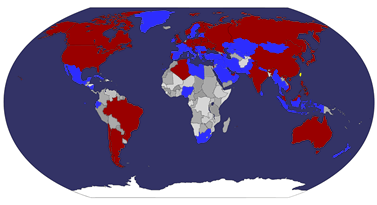Le lancement de Satellite Artificiel de Terre "Kwangmyongsong 2" dans le RPDC


Kwangmyŏngsŏng-2 (Chosungul: 광명성 2호, Hanja: 光明星 2號, meaning Bright Star-2 or Lode Star-2) was a satellite the North Korean government claimed to have placed into orbit in April 2009. According to the North Korean government, an Unha-2 rocket carrying the satellite was launched on Sunday 5 April 2009 at 11:20 local time (02:20 UTC) from the Tonghae Satellite Launching Ground at Musudan-ri in northeastern North Korea. However, officials in South Korea and the United States reported that the rocket and any payload had fallen into the Pacific Ocean. The Russian Space Control concurred, stating that the satellite "simply is not there".
Prior to the launch, concern was raised by other nations, particularly the United States, South Korea and Japan, that the rocket was a Taepodong-2, and the launch might be a trial run of technology that could be used in the future to launch an intercontinental ballistic missile. The launch of the rocket was sharply condemned by the United States and the European Union, while the People's Republic of China and Russia urged restraint.
“ The successful satellite launch symbolic of the leaping advance made in the nation's space science and technology was conducted against the background of the stirring period when a high-pitched drive for bringing about a fresh great revolutionary surge is under way throughout the country to open the gate to a great prosperous and powerful nation without fail by 2012, the centenary of birth of President Kim Il Sung, under the far-reaching plan of General Secretary Kim Jong Il. This is powerfully encouraging the Korean people all out in the general advance.”
—KCNA, KCNA on DPRK's Successful Launch of Satellite Kwangmyongsong-2
Rodong Sinmun, the official newspaper of the Central Committee of the Workers' Party of Korea, reported that North Korean leader Kim Jong-il "felt regret for not being able to spend more money on the people's livelihoods and was choked with sobs" during the launch.
In the following days, North Korea released images of the purported rocket launch. A mass rally by thousands of North Koreans took place in Kim Il-sung Square, Pyongyang to celebrate the "successful" launch of the satellite.
On 29 April, the state-run Korean Central News Agency reported that "North Korea threatened to conduct a nuclear test and more ballistic missile tests if the U.N. Security Council doesn't apologize to North Korea and withdraw its condemnation of Pyongyang's rocket launch earlier this month."On 25 May, North Korea claimed that it had conducted a second nuclear test.
In August 2009, postage stamps commemorating the launch were brought into circulation. The souvenir sheet says "Launch of Artificial Satellite 'Kwangmyongsong No. 2' in the DPRK."
Kwangmyŏngsŏng 2 (Hangul : 광명성 2호, Hanja : 光明星 2號) est un satellite de communications lancé le 5 avril 2009 par la République populaire démocratique de Corée.
La Corée du Nord a informé l'Organisation de l'aviation civile internationale (ICAO) qu'elle lancerait un « satellite de communications » sur une fusée Unha-2 entre le 4 et le 8 avril 2009. Ce supposé satellite a été nommé « Kwangmyŏngsŏng-2 », ce qui signifie « La Voie Lactée 2 » en coréen ; selon le gouvernement nord-coréen, il effectuerait des révolutions en orbite, et diffuserait des chants patriotiques à la gloire du régime. Cependant, des analystes en sécurité militaire ont supposé qu’il s’agirait d’un test de missile balistique Taepodong-2 à longue portée qui pourrait potentiellement atteindre des cibles japonaises ou le continent américain. Le 5 avril 2009, la fusée a été lancée vers 2 h 30 TU (11:30 heures KST). L'United States Northern Command a affirmé que le premier étage de la fusée est tombé dans la mer du Japon, alors que l'autre partie de la fusée, de même que la charge, est tombée dans l'océan Pacifique, et qu'aucun objet n’est entré en orbite. Le missile a volé apparemment 3 000 km avant de tomber dans l'océan (les autorités nord-coréennes ont cependant affirmé sur leur site officiel que le satellite a bien été mis en orbite avec succès). Selon les analystes sud-coréens, le Taepodong-2 aurait parcouru au moins 3 200 kilomètres.











.png)




















 taiwan
taiwan  cover or postcard
cover or postcard  FDC
FDC 






























































































No comments:
Post a Comment